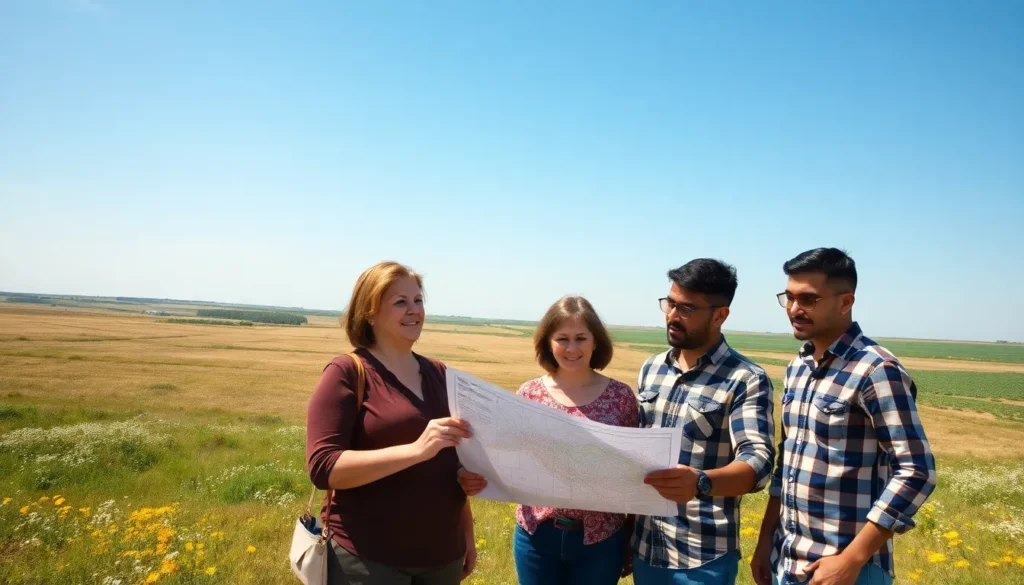Imagine stumbling upon a treasure chest filled with endless possibilities—yep, that’s vacant land for you! Whether it’s a sprawling field waiting for a dream home or a tiny lot perfect for a quirky garden, vacant land is like that blank canvas just begging for creativity.
Table of Contents
ToggleUnderstanding Vacant Land
Vacant land represents a unique opportunity for investment and development. Owners may use it for various purposes, including residential construction, commercial ventures, or agricultural uses. Each type of vacant land serves distinct possibilities based on location, size, and zoning regulations.
When considering location, proximity to urban centers often enhances value. Properties situated near amenities increase desirability for potential buyers or renters. They can attract interest from individuals who want easy access to schools, shopping, and recreational services.
Size profoundly impacts usability. Large parcels provide ample space for extensive developments, like subdivisions or recreational facilities. Smaller plots might appeal to those interested in tiny homes or urban gardens. Each size accommodates different needs or visions.
Zoning regulations dictate permissible activities on vacant land. These regulations vary by municipality, defining whether the land is residential, commercial, or agricultural. Buyers must research zoning laws before purchase to understand limitations and potential developments.
Investment potential exists, regardless of the intended usage. Purchasing vacant land often requires less initial capital compared to developed properties. An investor might focus on markets experiencing growth, as land appreciates over time. They could explore vacant land in areas projected to undergo infrastructure improvements.
Many individuals view vacant land as a blank canvas. It allows for personalization and creativity in developing a vision. Developing a residential area tailored to personal preferences or a commercial venture aligned with market needs offers significant satisfaction and potential returns.
Types of Vacant Land

Various types of vacant land exist, each catering to different needs and purposes. Understanding these categories aids potential buyers in making informed decisions.
Residential Land
Residential land focuses on housing developments. Plots typically suit single-family homes or multi-family units. Zoning laws dictate permissible structures. Locations near urban centers enhance attractiveness for homebuilders or investors targeting rental income. Smaller parcels cater to tiny homes or townhouses. They appeal to buyers seeking affordable housing options. Developers often seek larger parcels for building subdivisions, illustrating the importance of size in decisions.
Commercial Land
Commercial land serves business ventures. Properties can accommodate retail stores, offices, or warehouses. Proximity to major highways or dense populations drives demand. Zoning regulations dictate what types of businesses can establish a presence. Investors targeting profitability often focus on high-traffic areas. Flat terrain is preferred for construction, making site selection crucial. An appealing location enhances visibility, encouraging foot traffic for retail enterprises.
Agricultural Land
Agricultural land focuses on farming and livestock operations. These parcels often feature fertile soil, favorable climates, and access to water sources. Farmers or investors targeting crop production prioritize such qualities. Zoning also influences this type of land, affecting what crops or livestock may be raised. In certain regions, agribusiness opportunities flourish, fostering economic growth. Additionally, some investors explore sustainable practices, integrating modern techniques into traditional farming.
Benefits of Investing in Vacant Land
Investing in vacant land presents multiple advantages that attract savvy investors.
Long-Term Appreciation
Long-term appreciation ranks high among the benefits. Historically, vacant land appreciates significantly in value over time, especially in high-demand areas. Population growth and urban development often drive this upward trend. Investors can realize substantial returns when selling in the future, particularly in expanding markets. Affordability tends to be an additional factor, as land typically costs less upfront than developed properties. It becomes increasingly sought-after as cities expand their boundaries. Analyzing market trends helps investors identify potential appreciation opportunities.
Flexibility for Development
Flexibility for development stands out as another critical benefit. Vacant land offers a blank slate that allows for various uses, such as residential homes, commercial centers, or agricultural projects. Investors choose the type of construction that aligns with their goals and market demand. Zoning regulations dictate permissible uses but can offer multiple options when favorable. Development timelines also remain manageable since initial construction typically takes less time than renovation projects. It allows investors to adapt quickly to evolving market conditions. That adaptability enhances investment attractiveness, giving potential for personalized projects to meet community needs.
Risks and Challenges
Investing in vacant land includes various risks and challenges that potential buyers should understand. Zoning regulations often dictate permissible uses, impacting potential projects.
Zoning Regulations
Navigating zoning regulations is crucial for any vacant land investment. Different municipalities enforce various zoning laws that determine how land can be used. Residential spaces typically have restrictions on development type and density, while commercial areas focus on business operations and signage. Buyers must research local zoning ordinances for intended uses to avoid costly surprises. Failing to comply can result in fines or project delays. Therefore, understanding these regulations shapes the successful development of vacant land.
Environmental Concerns
Environmental issues also pose significant risks for vacant land investors. Contamination from previous industrial activities can lead to costly remediation requirements. Soil quality affects suitability for agriculture or construction, with certain areas at higher risk of erosion or flooding. Buyers should conduct environmental assessments to identify hidden issues prior to purchase. Ignoring these concerns can result in unexpected expenses and limit development options. Each site presents unique challenges related to its environmental state, warranting thorough investigation.
Market Trends
Current trends in vacant land reflect an increasing demand driven by urbanization and shifting lifestyles. Buyers gravitate toward locations with growth potential, particularly areas near expanding urban centers. A rise in remote work has influenced purchasing preferences, leading many to seek larger plots outside city limits for personal projects or retreat homes.
Investors are showing interest in residential land, knowing that housing shortages in key markets can drive appreciation. Additionally, commercial lots are gaining attention for their potential to support various business ventures, especially in areas experiencing high foot traffic. Agricultural land, while often overlooked, remains vital as food security concerns grow.
Reports indicate that vacant land typically appreciates at a rate of 3% to 5% annually. Notably, regions with favorable zoning regulations and infrastructure development exhibit higher appreciation rates. Proximity to amenities, schools, and transportation hubs significantly influences buyer interest and land value.
Market fluctuations can create both opportunities and challenges. Despite potential risks, such as economic downturns or regulatory changes, the long-term outlook for vacant land remains promising. Buyers seeking to invest must remain informed about local market trends and zoning dynamics to maximize their investment.
Understanding these market trends is critical for potential investors. While the landscape changes, the fundamental appeal of vacant land continues to attract those looking for space to build, develop, or farm. Awareness of these trends positions investors for success, ensuring they make informed decisions in a dynamic marketplace.
Investing in vacant land offers a unique opportunity for creativity and growth. With its potential for appreciation and flexibility in use, it stands as a promising option for those looking to enter the real estate market. Understanding local zoning regulations and conducting thorough environmental assessments can mitigate risks and enhance the investment experience.
As urbanization continues to shape demand, vacant land remains a valuable asset. Buyers and investors who stay informed about market trends will find themselves well-positioned to capitalize on the opportunities that vacant land presents. Whether for personal projects or investment purposes, the possibilities are vast and exciting.





